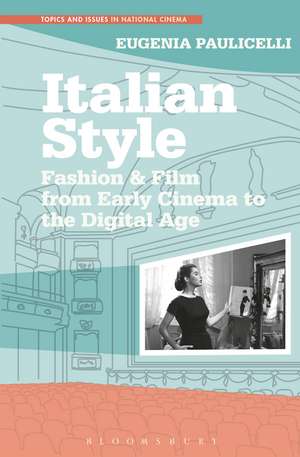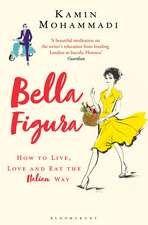Italian Style: Fashion & Film from Early Cinema to the Digital Age: Topics and Issues in National Cinema
Autor Professor Eugenia Paulicellien Limba Engleză Paperback – 20 sep 2017
| Toate formatele și edițiile | Preț | Express |
|---|---|---|
| Paperback (1) | 238.67 lei 6-8 săpt. | |
| Bloomsbury Publishing – 20 sep 2017 | 238.67 lei 6-8 săpt. | |
| Hardback (1) | 774.62 lei 6-8 săpt. | |
| Bloomsbury Publishing – 21 sep 2016 | 774.62 lei 6-8 săpt. |
Preț: 238.67 lei
Preț vechi: 273.26 lei
-13% Nou
45.67€ • 47.81$ • 37.79£
Carte tipărită la comandă
Livrare economică 05-19 aprilie
Specificații
ISBN-10: 1501334921
Pagini: 288
Ilustrații: 40 bw illus/16 color illus
Dimensiuni: 152 x 229 x 21 mm
Greutate: 0.41 kg
Ediția:NIP
Editura: Bloomsbury Publishing
Colecția Bloomsbury Academic
Seria Topics and Issues in National Cinema
Locul publicării:New York, United States
Caracteristici
Notă biografică
Eugenia Paulicelli is Professor of Italian, Comparative Literature and Women's Studies at Queens College and The Graduate Center, The City University of New York (CUNY), USA. At The Graduate Center she directs Fashion Studies in the Master of Arts in Liberal Studies (MALS) and the PhD Concentration. Among her books: Fashion under Fascism: Beyond the Black Shirt (2004); Moda e Moderno (editor, 2006); The Fabric of Cultures: Fashion, Identity, Globalization (co-editor, 2009); Writing Fashion in Early Modern Italy (2014); Rosa Genoni: Fashion is a Serious Business (2015). Visit her website at www.eugeniapaulicelli.com.
Cuprins
List of Illustrations vii Acknowledgments xi 1 Fashion, Film, Modernity 1 Nostra Dea: the goddess of fashion 1 Pirandello, cinema, and clothing: elective affinities 4 "The Tight Frock-Coat": performing dress 7 Film, costume, fashion, and intermediality 10 Italian style: fashion and film 10 2 Italian Fashion and Film in the 1910s: From the Futurists to Rosa Genoni 19 The Futurists, fashion, film, and performance 20 Rosa Genoni: Per una moda italiana: fashioning the diva 26 3 From the Body of the Diva to the Body of the Nation 41 The Italian divas and the "gowns of emotions" 41 Lyda Borelli (1887-1959): the ethereal melancholic beauty and Ma l'amore mio non muore! (love everlasting) 48 The veil: modernity in motion in Nino Oxilia's Rapsodia Satanica 54 Francesca Bertini (1892-1985): the glamorous embodied 63 Nino Oxilia's Sangue Bleu (1914) and Gustavo Serena's Assunta Spina (1915) 63 Pina Menichelli (1890-1981): "the other woman" and the end of an era 69 4 Fashion, Film, Modernity, under Fascism 77 Fashion in motion: the LUCE newsreels 81 Rhythms of the modern city: fashion in Corrado D'Errico's Stramilano (1929) 88 Contessa di Parma (Alessandro Blasetti, 1937): a manifesto for the promotion of Italian fashion and Turin as a fashion city 91 Grandi Magazzini (1939, Mario Camerini): fashion consumption, gender roles, and work in Milan 101 Epilogue: towards a new dawn 106 5 Launching Italian Style in Cinema and Fashion: The Films of Michelangelo Antonioni 113 The fabric of film: Sette canne, un vestito (1949) 113 The 1950s: Cronaca di un amore, La signora senza camelie and Le amiche 119 The fashion show in Cronaca: a narrative mise en abyme 127 "Was I a good femme fatale?" (Lucia Bosè (Clara) in La signora senza camelie) 128 The fashion show in Le amiche: the end of the game 132 The 1960s: from costume to fashion. L'Avventura and beyond 133 Outsiders, doubles, wanderers 137 Conclusion: a visual tactility 151 6 Rome, Fashion, Film 157 From "Hollywood on the Tiber" to La Dolce Vita 157 Rome as a fashion city in the postwar years 161 La Dolce Vita 170 La Dolce Vita and its discontents 174 Roma (Fellini, 1971): space and time 175 The broken watch of history 177 The ecclesiastical fashion show 178 7 After La Dolce Vita: La Grande Bellezza (2013) by Paolo Sorrentino 185 Fashion, film, and Rome today: national identity revisited 192 Appendices: The Photographic Archive by Giuseppe Palmas (1918-1977) 195 Interview with Fernanda Gattinoni, Rome, June 16, 2000 199 Dressing the Dreams: Interview with Dino Trappetti-Tirelli Costumi Rome, December 2015 207 Interview with Teresa Allegri, founder of Annamode, Rome, Fondazione Annamode, June 6, 2013 215 Adriana Berselli 227 Some notes on the set of L'avventura (1960) by Michelangelo Antonioni 227 "Cesare Attolini" and La Grande Bellezza: Interview with Massimiliano Attolini, Son of Cesare and Grandson of Vincenzo, Founder of the Sartoria 233 Selected Bibliography 239 Filmography 255 Index 259
Recenzii
"Paulicelli's book is a tour de force of film and fashion scholarship, a beautifully written and authoritative exploration of Italian national identity that will appeal to a wide readership. In mapping out Italy's rich cultural heritage from early twentieth century modernism, through the economic miracle years to the present day, this book sets out to do nothing less than define Italian style as embodied by the dialogue between fashion and film. That Italian Style achieves this is testament to its brilliance."
Descriere
This is the first in-depth, book-length study on fashion and Italian cinema from the silent film to the present. Italian cinema launched Italian fashion to the world. The book is the story of this launch. The creation of an Italian style and fashion as they are perceived today, especially by foreigners, was a product of the post World War II years. Before then, Parisian fashion had dominated Europe and the world. Just as fashion was part of Parisian and French national identity, the book explores the process of shaping and inventing an Italian style and fashion that ran parallel to, and at times took the lead in, the creation of an Italian national identity. In bringing to the fore these intersections, as well as emphasizing the importance of craft in cinema, fashion and costume design, the book aims to offer new visions of films by directors such as Nino Oxilia, Mario Camerini, Alessandro Blasetti, Federico Fellini, Michelangelo Antonioni, Luchino Visconti and Paolo Sorrentino, of film stars such as Lyda Borelli, Francesca Bertini, Pina Menichelli, Lucia Bosè, Monica Vitti, Marcello Mastroianni, Toni Servillo and others, and the costume archives and designers who have been central to the development of Made in Italy and Italian style.











